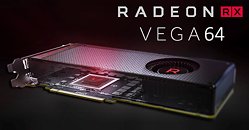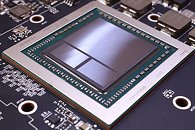Friday, September 1st 2017

On AMD's Raja Koduri RX Vega Tweetstorm
In what is usually described as a tweetstorm, AMD's RTG leader Raja Koduri weighed in on AMD's RX Vega reception and perception from both the public and reviewers. There are some interesting tidbits there; namely, AMD's option of setting the RX vega parts at frequencies and voltages outside the optimal curve for power/performance ratios, in a bid to increase attractiveness towards the performance/$ crowds.
However, it can be said that if AMD had done otherwise, neither gamers nor reviewers would have been impressed with cards that potentially delivered less performance than their NVIDIA counterparts, while consuming more power all the same (even if consuming significantly less wattage). At the rated MSRP (and that's a whole new discussion), this RTG decision was the best one towards increasing attractiveness of RX Vega offerings. However, Raja Koduri does stress Vega's dynamic performance/watt ratios, due to the usage of specially defined power profiles.To our forum-walkers: this piece is marked as an editorial
Raja also touched an interesting subject; namely, that "Folks doing perf/mm2 comparisons need to account for Vega10 features competing with 3 different competitive SOCs (GP100, GP102 and GP104)". This is interesting, and one of the points we have stressed here on TPU: AMD's Vega architecture makes great strides towards being the architecture AMD needs for its server/AI/computing needs, but it's a far cry from what AMD gamers deserve. it's always a thin line to be threaded by chip designers on which features and workloads to implement/improve upon with new architectures. AMD, due to its lack of a high-performance graphics chip, was in dire need of a solution that addressed both the high-performance gaming market and the server/computing market where the highest profits are to be made.This round, the company decided to focus its developments more towards the server side of the equation - as Raja Koduri himself puts it relative to Infinity Fabric: "Infinity fabric on Vega is optimized for server. It's a very scalable fabric and you will see consumer optimized versions of it in future." Likely, this is Raja's way of telling us to expect MCMs (Multi-Chip-Modules) supported by AMD's Infinity Fabric, much as we see with Ryzen. This design philosophy allows companies to design smaller, more scalable and cheaper chips, which are more resistant to yield issues, and effectively improve every metric, from performance, to power and yield, compared to a monolithic design. NVIDIA themselves have said that MCM chip design is the future, and this little tidbit by Raja could be a pointer towards AMD Radeon's future in that department.That Infinity Fabric is optimized for servers is a reflection of the entire Vega architecture; AMD's RX Vega may be gaming-oriented graphics cards, but most of the architecture improvements aren't capable of being tapped by already-existent gaming workloads. AMD tooled its architecture for a professional/computing push, in a bid to fight NVIDIA's ever-increasing entrenchment in that market segment, and it shows on the architecture. Does this equate to disappointing (current) gaming performance? It does. And it equates to especially disappointing price/performance ratios with the current supply/pricing situation, which the company still hasn't clearly and forcefully defined. Not that they can, anyway - it's not like AMD can point the finger towards the distributors and retailers that carry their products with no repercussion, now can they?Raja Koduri also addressed the current mining/gamer arguments, but in a slightly deflective way: in truth, every sale counts as a sale for the company in terms of profit (and/or loss, since rumors abound that AMD is losing up to $100 with every RX Vega graphics card that is being sold at MSRP). An argument can be made that AMD's retreating market share on the PC graphics card market would be a never-ending cycle of lesser developer attention towards architectures that aren't that prominent in their user bases; however, I think that AMD considers they're relatively insulated from that particular issue due to the fact that the company's graphics solutions are embedded into the PS4, PS4 Pro, Xbox One S consoles, as well as the upcoming Xbox One X. Developers code for AMD hardware from the beginning in most games; AMD can certainly put some faith in that as being a factor to tide their GPU performance over until they have the time to properly refine an architecture that shines at both computing and gaming environments. Perhaps when we see AMD's Navi, bolstered by AMD's increased R&D budget due to a (hopefully) successful wager in the professional and computing markets, will we see an AMD that can bring the competition to NVIDIA as well as they have done for Intel.
Sources:
Raja Koduri's Twitter, via ETeknix
However, it can be said that if AMD had done otherwise, neither gamers nor reviewers would have been impressed with cards that potentially delivered less performance than their NVIDIA counterparts, while consuming more power all the same (even if consuming significantly less wattage). At the rated MSRP (and that's a whole new discussion), this RTG decision was the best one towards increasing attractiveness of RX Vega offerings. However, Raja Koduri does stress Vega's dynamic performance/watt ratios, due to the usage of specially defined power profiles.To our forum-walkers: this piece is marked as an editorial
Raja also touched an interesting subject; namely, that "Folks doing perf/mm2 comparisons need to account for Vega10 features competing with 3 different competitive SOCs (GP100, GP102 and GP104)". This is interesting, and one of the points we have stressed here on TPU: AMD's Vega architecture makes great strides towards being the architecture AMD needs for its server/AI/computing needs, but it's a far cry from what AMD gamers deserve. it's always a thin line to be threaded by chip designers on which features and workloads to implement/improve upon with new architectures. AMD, due to its lack of a high-performance graphics chip, was in dire need of a solution that addressed both the high-performance gaming market and the server/computing market where the highest profits are to be made.This round, the company decided to focus its developments more towards the server side of the equation - as Raja Koduri himself puts it relative to Infinity Fabric: "Infinity fabric on Vega is optimized for server. It's a very scalable fabric and you will see consumer optimized versions of it in future." Likely, this is Raja's way of telling us to expect MCMs (Multi-Chip-Modules) supported by AMD's Infinity Fabric, much as we see with Ryzen. This design philosophy allows companies to design smaller, more scalable and cheaper chips, which are more resistant to yield issues, and effectively improve every metric, from performance, to power and yield, compared to a monolithic design. NVIDIA themselves have said that MCM chip design is the future, and this little tidbit by Raja could be a pointer towards AMD Radeon's future in that department.That Infinity Fabric is optimized for servers is a reflection of the entire Vega architecture; AMD's RX Vega may be gaming-oriented graphics cards, but most of the architecture improvements aren't capable of being tapped by already-existent gaming workloads. AMD tooled its architecture for a professional/computing push, in a bid to fight NVIDIA's ever-increasing entrenchment in that market segment, and it shows on the architecture. Does this equate to disappointing (current) gaming performance? It does. And it equates to especially disappointing price/performance ratios with the current supply/pricing situation, which the company still hasn't clearly and forcefully defined. Not that they can, anyway - it's not like AMD can point the finger towards the distributors and retailers that carry their products with no repercussion, now can they?Raja Koduri also addressed the current mining/gamer arguments, but in a slightly deflective way: in truth, every sale counts as a sale for the company in terms of profit (and/or loss, since rumors abound that AMD is losing up to $100 with every RX Vega graphics card that is being sold at MSRP). An argument can be made that AMD's retreating market share on the PC graphics card market would be a never-ending cycle of lesser developer attention towards architectures that aren't that prominent in their user bases; however, I think that AMD considers they're relatively insulated from that particular issue due to the fact that the company's graphics solutions are embedded into the PS4, PS4 Pro, Xbox One S consoles, as well as the upcoming Xbox One X. Developers code for AMD hardware from the beginning in most games; AMD can certainly put some faith in that as being a factor to tide their GPU performance over until they have the time to properly refine an architecture that shines at both computing and gaming environments. Perhaps when we see AMD's Navi, bolstered by AMD's increased R&D budget due to a (hopefully) successful wager in the professional and computing markets, will we see an AMD that can bring the competition to NVIDIA as well as they have done for Intel.












131 Comments on On AMD's Raja Koduri RX Vega Tweetstorm
It's not that the Vega is a power hog, you simply used wrong benchmarks ... you know, the ones with wrong dynamic range, meaning the ones that have 100% GPU usage all the time :roll:
I would love not to be sarcastic sometimes, but Raja won't let me :shadedshu:
:wtf::shadedshu:
If he meant different voltage/temp/power curve profiles in multiple bios modes ... I think reviewers showed those, and here we have perf/watt for all bios modes www.techpowerup.com/reviews/AMD/Radeon_RX_Vega_64/32.html
111 watts power usage.
Just under stock 1070 performance for less wattage is still nice.Core and memory were still dynamic :p All the power save mode does it set the limit to -25%. I just put it to -50%.
....cue (valid) pricing argument.
Bah just the fake media sprouting fake news. We will make Amd great again:rolleyes:.- orange 45
and btw do you think your consistent hitting the power limits has anything to do with that 30% power slider increase ...
And to clarify, I'm talking can REALLY use the cores, like BF1... There are currently only a handful.